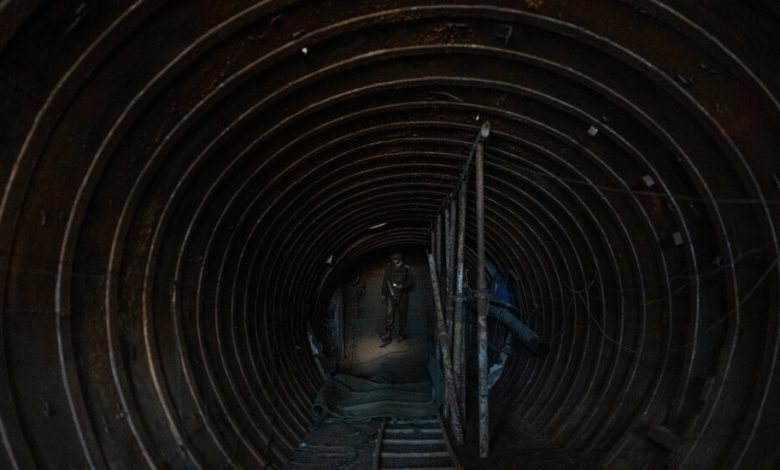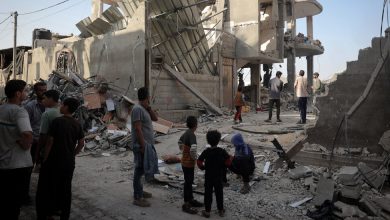Israel Unearths More of a Subterranean Fortress Under Gaza

One tunnel in Gaza was wide enough for a top Hamas official to drive a car inside. Another stretched nearly three football fields long and was hidden beneath a hospital. Under the house of a senior Hamas commander, the Israeli military found a spiral staircase leading to a tunnel approximately seven stories deep.
These details and new information about the tunnels, some made public by the Israeli military and documented by video and photographs, underscore why the tunnels were considered a major threat to the Israeli military in Gaza even before the war started.
But Israeli officials and soldiers who have since been in the tunnels — as well as current and former American officials with experience in the region — say the scope, depth and quality of the tunnels built by Hamas have astonished them. Even some of the machinery that Hamas used to build the tunnels, observed in captured videos, has surprised the Israeli military.
The Israeli military now believes there are far more tunnels under Gaza.
In December, the network was assessed to be an estimated 250 miles. Senior Israeli defense officials, who spoke on the condition of anonymity to discuss intelligence matters, are currently estimating the network is between 350 and 450 miles — extraordinary figures for a territory that at its longest point is only 25 miles. Two of the officials also assessed there are close to 5,700 separate shafts leading down to the tunnels.
The numbers could not be independently verified, and there are varying estimates by Israeli officials for the increased scope of the tunnel network, based on different intelligence. But the immense efforts of Hamas to militarize the enclave are not in dispute; nor are the intelligence failures of the Israeli military in underestimating the extent and importance of the network to Hamas’s survival.
In a meeting in January 2023, a top Israeli military official said the tunnels would not even be a factor in any future war with Hamas because of Israel’s military strength, according to a transcript of the discussion reviewed by The New York Times.
“Hamas has used the time and resources over the last 15 years to turn Gaza into a fortress,” said Aaron Greenstone, a former C.I.A. officer who has worked extensively in the Middle East.
For the Israeli military, the tunnels are a subterranean nightmare and the core of Hamas’s ability to survive. Every strategic goal of Israel in Gaza is now linked to wiping out the tunnels.
“If you want to destroy the leadership and arsenal of Hamas, you have to destroy the tunnels,” said Daphné Richemond-Barak, a tunnel warfare expert at Reichman University in Israel. “It’s become connected to every part of the military missions.”
Hamas has invested heavily in the tunnels since it does not have the resources or numbers to fight the Israeli military in a conventional war. The group uses the tunnels as military bases and arsenals, and relies on them to move its forces undetected and protect its top commanders.
One 2022 document showed Hamas budgeted $1 million on the tunnel doors, underground workshops and other expenses in Khan Younis.
Israeli intelligence officials recently assessed that there were about 100 miles of tunnels just under Khan Younis, southern Gaza’s largest city, where Israeli forces are now in heavy fighting. Yahya Sinwar, the military leader of Hamas in Gaza, had a home in Khan Younis.
In addition, a 2015 report indicated that Hamas had spent more than $3 million on tunnels throughout the Gaza Strip, including many built under civilian infrastructure and sensitive locations such as schools and hospitals, the Israeli military said.
The Israeli military said it had found two types of tunnels: ones used by commanders and others used by operatives. The commander tunnels are deeper and more comfortable, allowing for longer stays and use of ceramic tiles. The other tunnels are more spartan and often shallower.
An Israeli official said the military might have spent a year locating a single tunnel, but now the ground campaign has provided a trove of information about Gaza’s underground network.
The Israeli military has examined computers used by Hamas operatives in charge of tunnel construction to find the underground passageways, a senior Israeli official said. Some documents captured in the war are also proving vital. The Israeli military has found lists of the families that “hosted” the tunnel entrances in their private homes.
In one case, Israeli soldiers located a map of tunnels in Beit Hanoun, a city in northern Gaza, and used it to find and destroy tunnels. Even with this battlefield intelligence, the fighting in Gaza around the tunnels has been grueling. The Israeli military reports that nearly 190 soldiers have been killed and about 240 seriously wounded since the ground campaign started. But the military has not disclosed the number of dead and wounded in connection with the tunnel warfare.
One soldier, speaking on the condition of anonymity for safety reasons, said he oversaw the destruction of about 50 tunnels in Beit Hanoun. All of them were booby-trapped, he said. The soldier, an officer in the combat engineers, said his unit had found bombs hidden in walls and a massive explosive device that was hard-wired to be remotely activated.
The soldier, who was a reservist and has since been discharged, said the device had been made in a factory and had a serial number on it. If it had gone off, the bomb would have killed anybody in the tunnel and directly outside it, he said.
Hamas released a video in November showing how it lured a group of five Israeli soldiers to a tunnel entrance in Beit Hanoun and then used a roadside bomb to kill the soldiers.
Ms. Richemond-Barak said Hamas had imported the tactic from Syrian rebels who killed dozens of government troops in a tunnel attack in 2014 in Aleppo.
On Jan. 8, Israeli soldiers took journalists to see three tunnel shafts in central Gaza — one inside a one-story farm building on the outskirts of Bureij, the second inside a civilian steelworks on the edge of Maghazi and a third inside a shed near the steelworks.
The shaft in the steelworks was the deepest and most sophisticated. It descended roughly 30 yards and was fitted with some kind of elevator. The soldiers said it was used to transport munitions parts that were molded in the steelworks. A bucket of shells or rocket heads lay nearby. The soldiers said the shells were based on a template of a yellow U.S.-made mortar shell inscribed with the words “20 mm mortar shell; Lot 1-2008.”
The soldiers did not allow journalists into the shaft, citing the risk of explosions, but said Hamas would carry the munitions parts into the tunnel to transport them to another part of the tunnel network, where they would be fitted with explosives.
The tunnel was said to lead to a nearby shed made from corrugated iron. The journalists were escorted to that shed, where they saw 10 large rockets that were roughly three yards long and painted olive green. The rockets were contained in long oblong cages, possibly used to transport them.
The soldiers said the rockets had a range of roughly 60 miles. A shaft in the floor led underground, but it was unclear where the shaft led to, or how deep it was. It appeared shallower than the first shaft.
The logo of the Qassam brigades, the military wing of Hamas, was stuck to a wall.
Later, the Israeli Army published photos and video of the shafts and other nearby facilities. A Times photographer documented the military infrastructure, too.
The soldiers also took journalists to see a third tunnel shaft in a one-story farm building in Bureij, roughly a mile to the north, surrounded by farmland. They said the shaft had been hidden behind a locked door, which had been blown off its hinges. The journalists were again not allowed to enter the tunnel.
Outside, roughly 100 yards away, military bulldozers appeared to have unearthed part of the tunnel leading from the farm building. It was roughly five yards below the surface, arched in shape and wide enough for one person to pass comfortably.
Hamas has improved its ability to conceal the tunnels, but the senior official said the Israeli military had figured out one of the group’s operating models. The official called it the “triangle.” Whenever the Israeli military finds a school, a hospital or a mosque, soldiers know they can expect to locate an underground tunnel system beneath them, the official said.
Destroying the tunnels is not an easy task, the official said. They need to be mapped, checked for hostages and not just damaged but made irreparable. Recent attempts to demolish the tunnels by flooding them with seawater have failed.
The official estimated it could take years to disable the tunnel system.
Julian E. Barnes contributed reporting from Washington.





